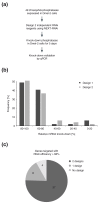Design and evaluation of genome-wide libraries for RNA interference screens
- PMID: 20550664
- PMCID: PMC2911109
- DOI: 10.1186/gb-2010-11-6-r61
Design and evaluation of genome-wide libraries for RNA interference screens
Abstract
RNA interference (RNAi) screens have enabled the systematic analysis of many biological processes in cultured cells and whole organisms. The success of such screens and the interpretation of the data depend on the stringent design of RNAi libraries. We describe and validate NEXT-RNAi, a software for the automated design and evaluation of RNAi sequences on a genome-wide scale. NEXT-RNAi is implemented as open-source software and is accessible at http://www.nextrnai.org/.
Figures





Similar articles
-
A Guide to Genome-Wide In Vivo RNAi Applications in Drosophila.Methods Mol Biol. 2016;1478:117-143. doi: 10.1007/978-1-4939-6371-3_6. Methods Mol Biol. 2016. PMID: 27730578 Review.
-
E-RNAi: a web application to design optimized RNAi constructs.Nucleic Acids Res. 2005 Jul 1;33(Web Server issue):W582-8. doi: 10.1093/nar/gki468. Nucleic Acids Res. 2005. PMID: 15980541 Free PMC article.
-
GenomeRNAi: a database for cell-based RNAi phenotypes. 2009 update.Nucleic Acids Res. 2010 Jan;38(Database issue):D448-52. doi: 10.1093/nar/gkp1038. Epub 2009 Nov 12. Nucleic Acids Res. 2010. PMID: 19910367 Free PMC article.
-
RNA Interference (RNAi) Screening in Drosophila.Genetics. 2018 Mar;208(3):853-874. doi: 10.1534/genetics.117.300077. Genetics. 2018. PMID: 29487145 Free PMC article.
-
Genome-wide RNAi as a route to gene function in Drosophila.Brief Funct Genomic Proteomic. 2004 Aug;3(2):168-76. doi: 10.1093/bfgp/3.2.168. Brief Funct Genomic Proteomic. 2004. PMID: 15355598 Review.
Cited by
-
Genome-wide RNAi screen identifies the Parkinson disease GWAS risk locus SREBF1 as a regulator of mitophagy.Proc Natl Acad Sci U S A. 2014 Jun 10;111(23):8494-9. doi: 10.1073/pnas.1321207111. Epub 2014 May 27. Proc Natl Acad Sci U S A. 2014. PMID: 24912190 Free PMC article.
-
Advances in genome-wide RNAi cellular screens: a case study using the Drosophila JAK/STAT pathway.BMC Genomics. 2012 Sep 24;13:506. doi: 10.1186/1471-2164-13-506. BMC Genomics. 2012. PMID: 23006893 Free PMC article.
-
E-TALEN: a web tool to design TALENs for genome engineering.Nucleic Acids Res. 2013 Nov;41(20):e190. doi: 10.1093/nar/gkt789. Epub 2013 Sep 3. Nucleic Acids Res. 2013. PMID: 24003033 Free PMC article.
-
Advances in RNAi-Assisted Strain Engineering in Saccharomyces cerevisiae.Front Bioeng Biotechnol. 2020 Jul 2;8:731. doi: 10.3389/fbioe.2020.00731. eCollection 2020. Front Bioeng Biotechnol. 2020. PMID: 32714914 Free PMC article. Review.
-
A genome-wide RNAi screen for genes important for proliferation of cultured Drosophila cells at low temperature identifies the Ball/VRK protein kinase.Chromosoma. 2023 Mar;132(1):31-53. doi: 10.1007/s00412-023-00787-6. Epub 2023 Feb 7. Chromosoma. 2023. PMID: 36746786 Free PMC article.
References
Publication types
MeSH terms
Substances
LinkOut - more resources
Full Text Sources
Other Literature Sources
Molecular Biology Databases

